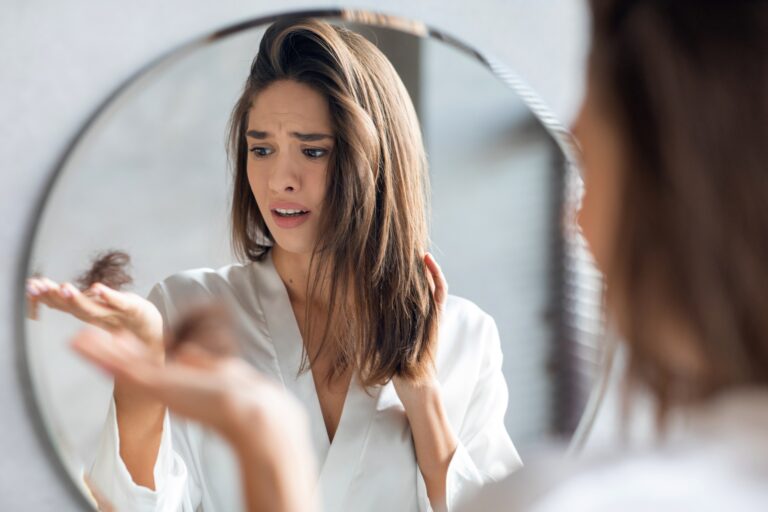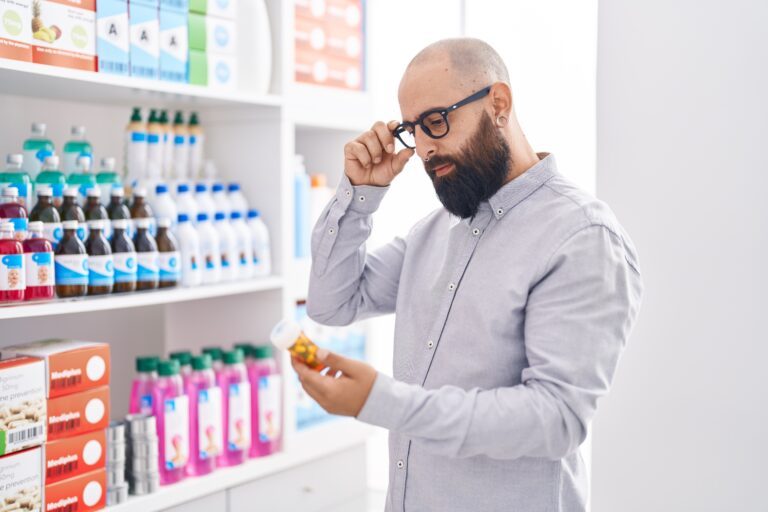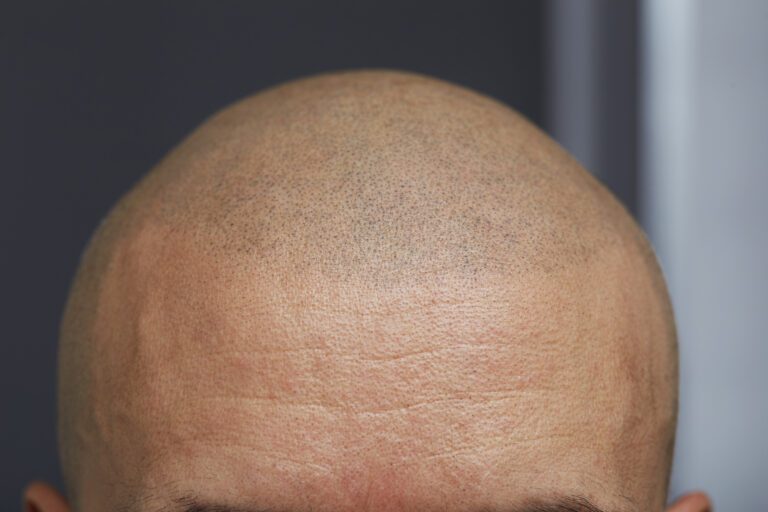What Results Can You Expect From Finasteride? Topical & Oral
Finasteride is one of the most effective treatments for hair loss in men, with upwards of 90% of patients displaying noticeable improvements within three to six months of use.
Finasteride is administered orally or topically. Oral Finasteride is the most common and accessible, but topical applications have been witnessing a huge comeback in the industry.
This article discusses the effectiveness of Finasteride in hair loss, the difference between oral and topical Finasteride, and Finasteride results after three, six, and 12 months.
What Is Finasteride?
Finasteride is a type of 5-alpha reductase inhibitor used to treat male pattern hair loss and benign prostatic hyperplasia (enlarged prostate). It’s also used to treat excessive hair growth in women with PCOS (Polycystic Ovary Syndrome).
Sold under the brand names Propecia and Proscar, Finasteride limits the production of dihydrotestosterone (DHT) in the body.
DHT is one of the primary contributors to hair loss in both men and women. Excessive DHT can shrink the hair follicles and shorten the hair growth cycle, thereby resulting in thinner, weaker hair.
Finasteride prevents the overproduction of DHT in the body, making it effective for those experiencing male pattern baldness.
It also reactivates “dead” hair follicles (i.e., follicles that are no longer producing hair), and delays the shedding process by allowing hair to remain in the resting phase for longer.
According to a study led by plastic surgeon Dr. Masayuki Yanagisawa, Finasteride prevented and treated male pattern baldness by 91.5% and 99.1%, respectively. These results were taken from 500+ Japanese male patients over the course of 10 years.
When Does Finasteride Take Effect?
Finasteride is a long-term medication, so it takes several months of continued treatment for results to show.
Most men notice positive results after a year of continued use, but the first signs of change usually appear within the first three to four months of taking the treatment.
Can Finasteride Cause Hair Shedding?
Towards the end of month two and into month three, you may experience something called Finasteride Shedding. Don’t worry—this is a normal part of the treatment process.
Hair grows in four stages. It starts with the anagen growth stage, then transitions into a catagen regressing phase. Approximately 10 days later, hair follicles enter the telogen resting stage, where follicles remain in the head but don’t actively grow. The final stage is called Exogen, where individual hair strands are released from their follicles and fall out.
Finasteride temporarily disrupts the hair growth cycle. Instead of following the normal four-cycle process, it skips ahead to the growth phase and begins the process of producing new hair.
Follicles in the catagen and telogen phases are pushed to end prematurely, causing them to fall out and make space for new growth.
After a certain period of taking Finasteride, you might find yourself shedding 50 to 150 hairs per day. The shedding can occur two to three months after taking the treatment, but some people experience it as early as two weeks.
Here’s the good news: Finasteride Shedding doesn’t usually take more than two weeks. If the shedding lasts more than two weeks, talk to your doctor for more advice.
Oral vs. Topical Finasteride: What’s the Difference?
Finasteride is administered in one of two formats: oral, in tablet form, or topical, in spray form.
Tablets contain 1 mg of Finasteride whereas topical formulations contain 0.1% Finasteride.
Topical Finasteride is just as effective as oral Finasteride, if not more. It also offers little to no side effects because it has less impact on serum DHT concentrations.
Oral Finasteride
The oral route is the most common method of Finasteride administration. It’s often taken once a day and paired up with 5% topical Minoxidil for improved results.
Finasteride tablets are readily manufactured across the world. They’re decently affordable, making them the go-to option for those who are experiencing hair loss.
These tablets are available in dosages of 1 to 5 mg. The usual dose for hair loss treatment is 1 mg, while the dose for enlarged prostate treatment is 5 mg.
Side Effects of Oral Finasteride
Some men prefer topical treatments due to the potential side effects brought about by the oral variant. Some of the most common side effects of oral Finasteride include:
- Decreased sexual desire
- Erectile dysfunction
- Reduction of semen released during sex
- Problems with ejaculation
These side effects happen to less than 2% of men and usually go away after several weeks.
On the off-chance that the symptoms don’t go away, doctors may prescribe a topical alternative to oral Finasteride.
Topical Finasteride
Topical Finasteride often comes in the form of a spray. They usually contain topical Minoxidil to enhance their effectiveness. The product is applied in areas where thinning is most prominent.
Patients who take topical Finasteride may see results earlier than those who take oral Finasteride, but not by a significant margin.
According to a study published in the Journal of Dermatology, men who applied 1 ml of the topical Finasteride once a week showed similar results to men taking 1 mg of oral Finasteride every day for seven days.
Another study shows that topical Finasteride reduced male pattern baldness by 68 to 75%, as opposed to oral Finasteride which reduced it by 62 to 72%.
In practice, the difference isn’t enough to warrant switching from oral to topical.
Generally, topical Finasteride takes more effort to apply than oral Finasteride. Instead of simply swallowing a tablet, you’ll have to manually spray the medication on the affected areas.
Moreover, topical formulations are more than double the cost of the tablet variant and aren’t as readily available. For many, the extra effort and cost aren’t worth it.
The best candidates for topical Finasteride are those who don’t like taking oral medication and men who experience side effects from the oral variant.
Topical Finasteride doesn’t reduce blood DHT levels as much as the oral form, so there’s less chance of experiencing the side effects associated with the former.
Side Effects of Topical Finasteride
Topical Finasteride’s side effects differ from oral Finasteride’s side effects. The most common include:
- Scalp pruritus (irritation or itchiness)
- Dandruff
- Contact dermatitis (scalp eczema)
- Burning sensation on the scalp
- Erythema (redness or inflammation of the scalp)
These symptoms are localized to the application site. They usually go away after several applications as the scalp gets used to the medication. If symptoms persist, contact your doctor.
Like oral Finasteride, topical Finasteride shouldn’t be taken by pregnant women or men with pregnant partners as it can cause abnormalities in a male fetus.
Finasteride Timeline: Before and After Photos
Regardless of how Finasteride is taken, you should notice a gradual, steady improvement within the first several months of taking the medication.
Finasteride Results After 1 to 3 Months
Within a few hours of taking Finasteride, the medication will start to reduce the DHT in your blood by approximately 70%. You won’t notice the effect straight away as it takes some time for the medication to introduce itself to the hair’s growth cycle.
Between months one to three, you’ll likely notice little to no improvements to your hair. Your crown, hairline, and general hair thickness will look more or less the same.
During this period, your hair will also start to shed. Don’t panic; this is actually one of the signs Propecia is working.
Finasteride Results After 6 Months
You’ll notice visible results after taking Finasteride regularly for three to six months.
Your hair loss will slow down or stop altogether, and you’ll notice improvements in problem areas like the hairline, temple, and crown.
Your hair density will slowly increase, which will eventually lead to fuller hair across the scalp.
No matter how small, notable improvements after three to six months are a good sign that Finasteride is working as expected.
Finasteride Results After 1 Year
You’ll find the greatest results at the one-year mark. Your hair will thicken by about 15% and you won’t experience thinning and/or shedding.
If you’re not happy with your results after a year of use, you might want to consider an alternative hair loss treatment like a hair transplant.
One year marks the “final” results of Finasteride treatment, but improvements won’t stop after the first year. Therefore, you shouldn’t stop the treatment even after you reach the desired results.
Continuous treatment is crucial for maintaining and restoring your hair to its natural fullness. If you stop taking the medication, your DHT levels will increase yet again and your hair will revert to how it was before the treatment.
Finasteride Results After 2 Years and Beyond
In terms of visual growth, there are limited results to be seen after the one-year mark. Year two displays a 16% improvement compared to the 14% improvement in year one.
After one year of treatment, you’re taking the medication to maintain your new head of hair rather than improve its appearance.
Tips On Maximizing the Efficacy of Finasteride
Like other medications, there are several things you can do to maximize the results of Finasteride.
Take Finasteride Once a Day
Finasteride is a long-term medication. It needs to be taken every day for several years for it to work.
It’s imperative that you take the treatment every day without fail unless your doctor instructs otherwise. Skipping doses may reduce its effectiveness and compromise your results.
Take Hair Loss Supplements
Hair loss supplements contain essential vitamins and minerals that promote hair growth, like biotin, collagen, omega-3 fatty acids, folic acid, and vitamins C and E.
They may also contain ingredients that are believed to strengthen hair, like lavender, peppermint, ginseng, and ashwagandha.
Taking these supplements with Finasteride can potentially speed up its results.
Invest In a High-Quality Hair Loss Prevention Shampoo
While taking the medication, use DHT-blocking hair loss shampoo to further stimulate growth and add thickness and volume to your hair.
Massage Your Scalp Every Day
Research shows that massaging the scalp helps promote hair growth. The soft pressure of the massage can increase blood circulation in the scalp, thereby allowing hair follicles to receive more nutrients.
Try to massage your scalp for at least 5 minutes at a time, several times a day. Work your way across the scalp with a massage tool, a brush, or your fingertips. You can also use essential oil while massaging your scalp. Peppermint and lavender are particularly effective in hair growth.
Avoid Excessive Shampooing and Styling
As much as possible, limit your use of chemical treatments, heated styling tools, dyes, and styling products as they can weaken hair cuticles. Don’t over-shampoo, either. The chemicals in the shampoo may turn your hair brittle and dry, leading to hair fall.
Avoid Smoking and Drinking Alcohol
Smoking and alcohol damage the hair follicles and the immune system, which can lead to diseases or illnesses that cause hair loss. They may also cause the blood vessels to shrink, thereby interrupting the hair’s growth cycle.
Quitting both alcohol and cigarettes not only increases the effectiveness of Finasteride but also restores the hair growth cycle.
Final Thoughts
As with most hair loss treatments, Finasteride takes a while to work.
If you take Finasteride once a day, you should start to see results within three to six months. The final results can be visible after one year of treatment.
Oral Finasteride and topical Finasteride have nearly the same efficacy, so taking one over the other won’t affect the results by a large margin. Though if you experience any of the symptoms associated with oral Finasteride, topical Finasteride is your best option.







